It is believed that 90 percent of chess games are decided by tactics. Tactics are a sequence of moves that often results in material advantage or checkmate.
Without tactical awareness, it would be difficult to gain an advantage over your opponent or to even defend properly.
If you wish to get better as a chess player, you need to know the general or basic tactics that are present throughout most chess games. In this article, I will show you all the major tactics every beginner chess player should know, including examples from real games.
With that said, here are 15 must know chess tactics for beginners:
1. Fork (Double Attack)
The fork is the most common and basic tactics in chess. It happens when a piece makes 2 or more direct attacks at the same time. This is why it’s also known as Double Attack.
Every piece on the chess board has the ability to perform a fork or double attack against 2 or more of the opponent’s pieces. From the knight, bishop, and rook, to the queen and pawn. Even the king can fork 2 or more pieces at once.
However, one of the best pieces that is well known for forking is the knight. Because the knight pounces about on the chess board in the most unusual way, a lot of players tend to fall for its traps. A knight is also called a squid or octopus because it can jump to 8 possible squares, thereby forking up to 8 pieces at maximum.
As a rule of thumb, whenever there is a knight on the chess board, always look out for potential forks in the position.
Here is an example of a knight forking a king and queen
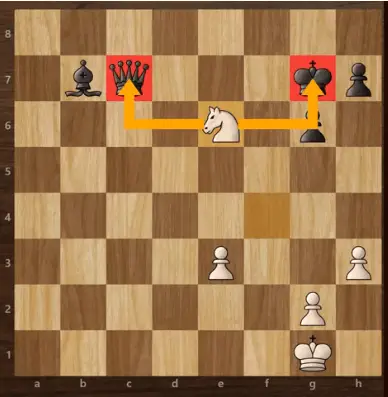
The white knight is attacking both the black queen and the black king. After the king moves out of check, the white knight will capture the black queen on c7.
Example #2: Rook forking a knight and a bishop

In the position above, white just played his rook to c7, forking the knight and bishop. Black cannot defend both pieces at once and will therefore lose a piece.
2. Pin
A pin is a common tactical element in the game of chess. It occurs when a piece is held in place and cannot move without giving up a more valuable piece behind it.
In the position below, white played his queen to h8. This move pins the black bishop along the backrank as it cannot leave the black king undefended.

A piece that is pinned to a king is the strongest type of pin because it would be illegal to break the pin and expose the king to an attack. Therefore, in this position, black cannot move his bishop since the king is behind it. White will win the bishop on the next move.
Types of pins
There are two types of pins:
- Absolute pin: When a piece is pinned to the king (As observed in our previous example)
- Relative Pin: When a piece is pinned to another piece of greater value (but not the king).
In the position below, white just played the move bishop to g5, pinning the black knight on f6 to the black queen on d8.
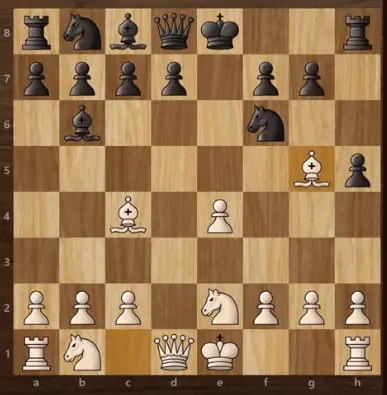
This type of pin is called a relative pin. Though the black knight is pinned to a piece of greater value, the knight can still legally move from the f6 square unlike in absolute pins that features the king.
However, even though black can legally move his knight, this would be a terrible move because he will then lose his queen.
You can only pin with 3 pieces (the bishop, queen and rook). The knight, pawn and king are not capable of pinning a piece.
3. Skewer
A skewer is an attack on 2 pieces that are lined up with one another, sharing the same file or diagonal. The first piece is the more valuable piece. When it moves out of the way, the less valuable piece behind it is captured.
In the position below, the white rook delivers check to the black king. After the black king moves out of the way, the white rook will capture the black queen on h7. This is called a skewer.
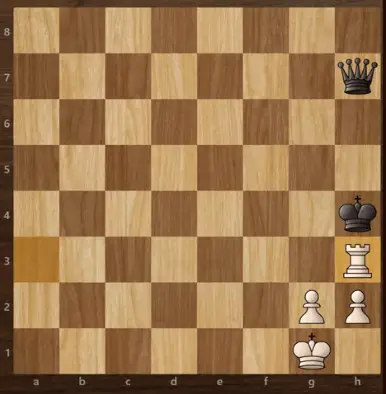
You can think of a skewer as the opposite of the pin. In a pin, the less valuable piece is in front, whereas in a skewer, the more valuable piece is in front. In this example, the most valuable piece (the king) came under check from the white rook and was forced to move out of the way, leaving the less valuable piece (the queen) open for capture.
Just like the pin, you can only skewer with 3 pieces: the queen, bishop and rook.
4. Discovered Attack
A discovered attack is one of the most dangerous beginner chess tactics. It occurs when one piece moves and uncovers an attack by another piece.
In the position below, white captures the g6 pawn with his bishop. By doing so, he has launched a discovered attack on the knight on d6.
Discovered attack

This is also called a ‘discovered double attack’ since white is attacking both of black’s pieces at once. The rook attacks the knight, whereas the bishop attacks black rook on h7.
The main idea behind discovered attacks is to clear the way for your piece. White was able to clear the bishop for the rook which revealed an attack against the black knight and the black rook in one move.
Since black cannot save both pieces in one move, white will win material and gain a solid advantage.
5. Discovered Check
A very effective form of discovered attack is the discovered check. This occurs when the uncovered piece checks the opposing king.
In the game below, white moves his rook from c3 to a3 and uncovers a discovered check on the black king, meanwhile attacking the black knight on a7.

Simultaneously, the rook on a3 is attacked. The difference between dicovered check and discovered attack is that discovered check is forcing. This means that the king will have to move away from the check. Therefore, in the position above, white will win the knight on a7 after the black king gets out of check.
6. Double Check
Another powerful form of the discovered check is the ‘discovered double check’. A double check is more dangerous because not only the hidden piece attacks the king, but also the piece that moves.
In the game below, white plays knight to f5 revealing a double check against the black king. Not only is the queen attacking the enemy king, but also the knight on f5.
Double check tactics
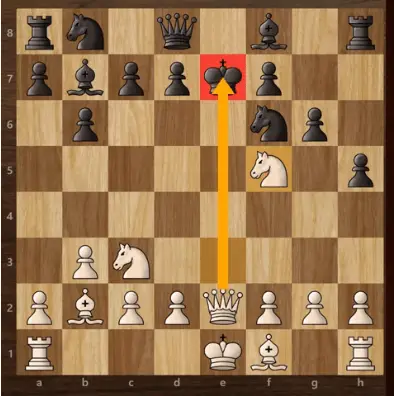
Whenever there is a double check, the enemy king has to move. In this game, since there are no safe squares for the king to go, it’s a brilliant checkmate!
7. Windmill Tactic
A windmill is a rare but devastating tactic in which a repeated discovered check allows one piece to go on a rampage, capturing multiple enemy pieces.
Let’s take a look.
In this game, white first sacrifices his queen and then captures on g7 with a check. This is the beginning of the windmill as you can see in the game below.
White delivers a series of checks which are all forced and inescapable. This leads to a series of captures and eventually white ends up with a huge material advantage after the rampage is complete. Windmill is by far the most brutal chess tactics to exist in chess, but a rare phenomenon to encounter.
8. Interference Tactic
Interference occurs when the line between an attacked piece and its defender is interrupted by interposing a piece.
In this game, both the black rooks are defending each other. However, white has an interference tactics with the move knight to c6 check.

The knight on c6 interferes with the 2 black rooks, thereby cutting off their connetivity and making the black rook on c3 vulnerable. Since this move comes with a check, white will capture the black rook on c3 after the black king is forced to move out of check. White gains material and has a winning advantage.
Interference tactic
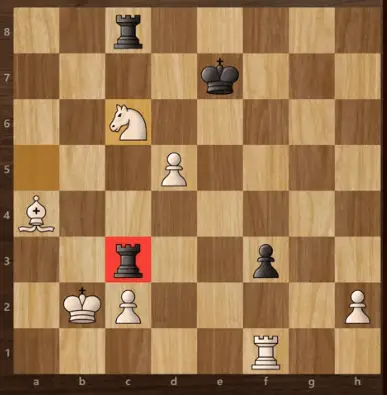
9. Overloading
As the name suggest, overloading is when one piece is assigned to protect multiple pieces, squares or threats at the same time. When this happens, we refer to that piece as being overloaded.
Let’s understand from this example how you can distract an overloaded piece from one of its protecting tasks.
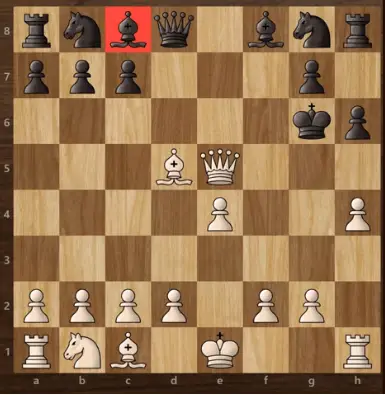
In the position above, the black bishop on c8 is defending 2 threats: preventing Queen f5 checkmate and protecting the b7 pawn.
Since this bishop is overloaded, white can take advantage by capturing the b7 pawn.

Black cannot take the bishop because of Qf5 checkmate. Eventually, black will lose material.
10. Deflection Tactic
The next tactic you need to know is the deflection tactic. As the name suggest, the idea is to chase away or deflect an enemy piece from an important square.
In this position, the black king is defending the rook on f8. If white can move the king away from the g8 square, he can take the black rook. So can you find a move to achieve that?

Yes, white can simply play Bishop h7 check to deflect the black king away from the important g8 square. After Kxh7, white can capture the rook and be up the exchange.
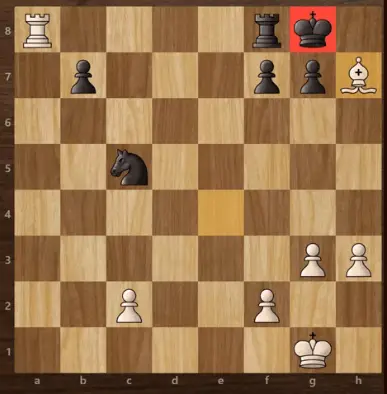
11. Decoy
Decoy is a tactic where you set up a trap for your opponent. It’s sort of related to deflection. In deflection we force the opponent away from a particular square, whereas in decoy we force him to move his piece to a particular square.
Such a square where we want to get him to is generally called a poison square. In other words, we play a move that forces the enemy piece to that poisoned square.
In the game below, black is completely dominating. One more move and black will checkmate the white king. However, it is white to move and checkmate the black king. Can you think of any way for white to win this immediately?

If you found it congrats! White can win by sacrificing his queen on f8. This forces the black king to capture the queen on f8. The black king on f8 is now forced into a mating net. White can now deliver the final blow with the move rook to c8 checkmate.
Decoy tactic to get the king in a mating net

12. X-Ray Attack
An x-ray attack is an indirect attack on an enemy piece or an indirect defense through an enemy piece. To understand this concept, let’s look at an example game.
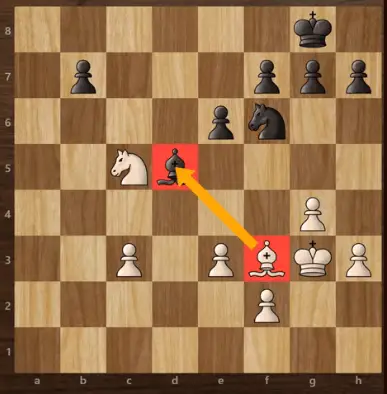
As you can see, the bishop on f3 is attacking the bishop on d5. At the same time, it’s indirectly attacking the pawn on b7. By using the x-ray tactic, white can take the pawn on b7 with the knight. If the black bishop captures the knight, white can recapture with the bishop and win a pawn at the end of the line.
13. Zugzwang
Zugzwang is a german word which means it is your turn to move but all your moves are bad. This is a situation where every move a player could make will significantly worsen his position, and at times even cause him to lose the game.
Here, white just played the waiting move Rook d8 placing black in zugzwang. The next move black makes (Kh8), white’s rook will capture the bishop and win the game.
Black is in Zugzwang

14. Zwischenzug
This is a german word meaning an intermediate move or an in between move.
It is a chess tactic in which a chess player inserts an unexpected move in between an otherwise forcing sequence of moves.
15. Removing The Defender
The next tactic we need to know is undermining which means removal of the defender. It involves attacking or capturing a critical defending piece to gain significant material advantage or even checkmate your opponent.
In the position below, the white queen can deliver checkmate on g7, but the black knight on e8 is defending that square. White can get rid of this defender by playing the move Rxe7 and then follow up with Qxg7 checkmate.
Removing the defender

Final Verdict
There you have it, the 15 must know chess tactics for beginners. It’s important to note that tactics can only show up in your games once you’ve achieved a positional advantage over your opponent. Therefore, while tactics is an important element in the game of chess, you also need to develop your positional understanding so that you can have a superior position over the board for these tactics to show up.


